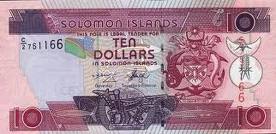|


The dollar (ISO 4217 code: SBD) is the currency of the Solomon Islands since 1977. It is normally abbreviated with the dollar sign "$" or, alternatively "SI$" to distinguish it from other dollar-denominated currencies. It is subdivided into 100 cents.
History
Prior to the Solomon Islands Dollar, Solomon Islands relied on foreign currencies, namely the Australian units of pound sterling. however, the Solomon Islands had also issued its own corresponding banknotes, sometimes called the Solomon Islands Pound.
When Solomon Islands fell under the control of Imperial Japan, the Oceanian pound became the official currency until after the war ended and the Pound was restored.
In 1966, the Australian dollar replaced the pound, and was circulated in the Solomon Islands Until 1976, shortly before independence.
The Solomon Islands dollar was introduced in 1977, replacing the Australian dollar at par, following independence. Until 1979, the two dollars remained equal. After a period of five months pegged at SI$1.05 = AU$1, the currency floated. Economic stagnation ensued, so over the next 28 years, and especially during the civil war of 2000-2003, inflation has taken its toll, with the Solomon Islands dollar now equal to 15 Australian cents.
As of 2008, due to the low valuation in the currency, many Islanders have taken to hoarding coins and giving them to children as souvenirs, sparking a coin shortage. Some more traditional monetary forms, such as dolphin teeth, have in a few areas taken the place of coins.
Half Pounds
The Solomon Islands dollar is not a true dollar in the sense that it is descended directly from the Spanish pieces of eight, as is the case with the US dollar, the Canadian dollar, and the East Caribbean Dollar. The Solomon Islands dollar is an off-shoot of the Australian dollar which is in turn essentially a half pound sterling. Australia followed the pattern of South Africa in that when it adopted the decimal system, it decided to use the half pound unit as opposed to the pound unit of account. The choice of the name dollar was motivated by the fact that the reduced value of the new unit corresponded more closely to the value of the US dollar than it did to the pound sterling. Other examples of dollars that are not true dollars for this same reason are the Cayman Islands dollar, the Australian dollar, the Jamaican dollar, the New Zealand dollar, the Fiji dollar, the Namibian dollar, the Rhodesian dollar, and the Zimbabwe dollar.
Examples of dollars that are directly related to the original Spanish dollar unit are the US dollar, the Canadian dollar, the Newfoundland dollar, the East Caribbean dollar, the Belize dollar, the Guyanese dollar, the Bermuda dollar, the Bahamian dollar, the Trinidad and Tobago dollar, the Barbados dollar, the Hong Kong dollar, the Straits dollar, the Malayan dollar, the Singapore dollar, and the Brunei dollar.
Coins
In 1977, coins were introduced in denominations of 1, 2, 5, 10 and 20 cents and 1 dollar. The cent coins were all the same sizes, weights, and compositions as the corresponding Australian coins, with the 1 dollar an equilaterally curved heptagonal (seven sided) coin minted in cupro-nickel. Uniquely enough, This seven sided dollar coin happens to predate the later Australian one by seven years. The reverse of each of the six original coins depicts the image of an item or symbol important to native culture.
In 1985, bronze-plated steel replaced bronze in the 1 and 2 cents, with nickel-clad steel replacing cupro-nickel in the 5, 10, and 20 cents in 1990. 1988 saw the introduction of 50 cent coins, which were dodecagonal (twelve sided) and minted in cupro-nickel. The 1988 50 cent was also the country's first circulation commemorative piece celebrating the tenth anniversary of independence. Later issues simply depict the national crest. Unlike the lower denominations, the 50 cent and 1 dollar continue to be minted in cupro-nickel rather than clad-steel.
With a high national inflation rate, the 1 and 2 cent coins are becoming much less widely used, with prices often being rounded off to the nearest 5 cents instead due to a low valuation and shortage of these coins. Unlike many of its neighboring south pacific countries, Solomon Islands remains one of the few in that region that has yet to discontinue the 1 and 2 cent coins and withdraw them from circulation.
All the coins of the Solomon Islands bear the portrait of the country's head of state, Queen Elizabeth II, Queen of the Solomon Islands.
Banknotes
In 1977, banknotes were introduced in denominations of 2, 5 and 10 dollars, with 20 dollar notes added in 1981. The first issues of banknotes depicted Queen Elizabeth II. However, all new series afterwards had her image replaced with that of the national crest. 50 dollar notes were first introduced in 1986, followed by 100 dollar notes in 2006.. A polymer two dollar banknote was issued in 2001 to replace the cotton fibre issue, but the banknote was reverted back to cotton in the 2006 series. The 2006 series also saw several new security features, including brighter background colors, a micro printed holofoil on the 50 and 100 dollar notes, a tapered serial number, and a weaved security thread.
All of the notes depict scenes of traditional daily life and things that are culturally important in the islands, with each note pertaining to a particular theme.
All banknotes are issued by the Central Bank of Solomon Islands.
The text on this page has been made available under the Creative Commons Attribution-ShareAlike License and Creative Commons Licenses
|
